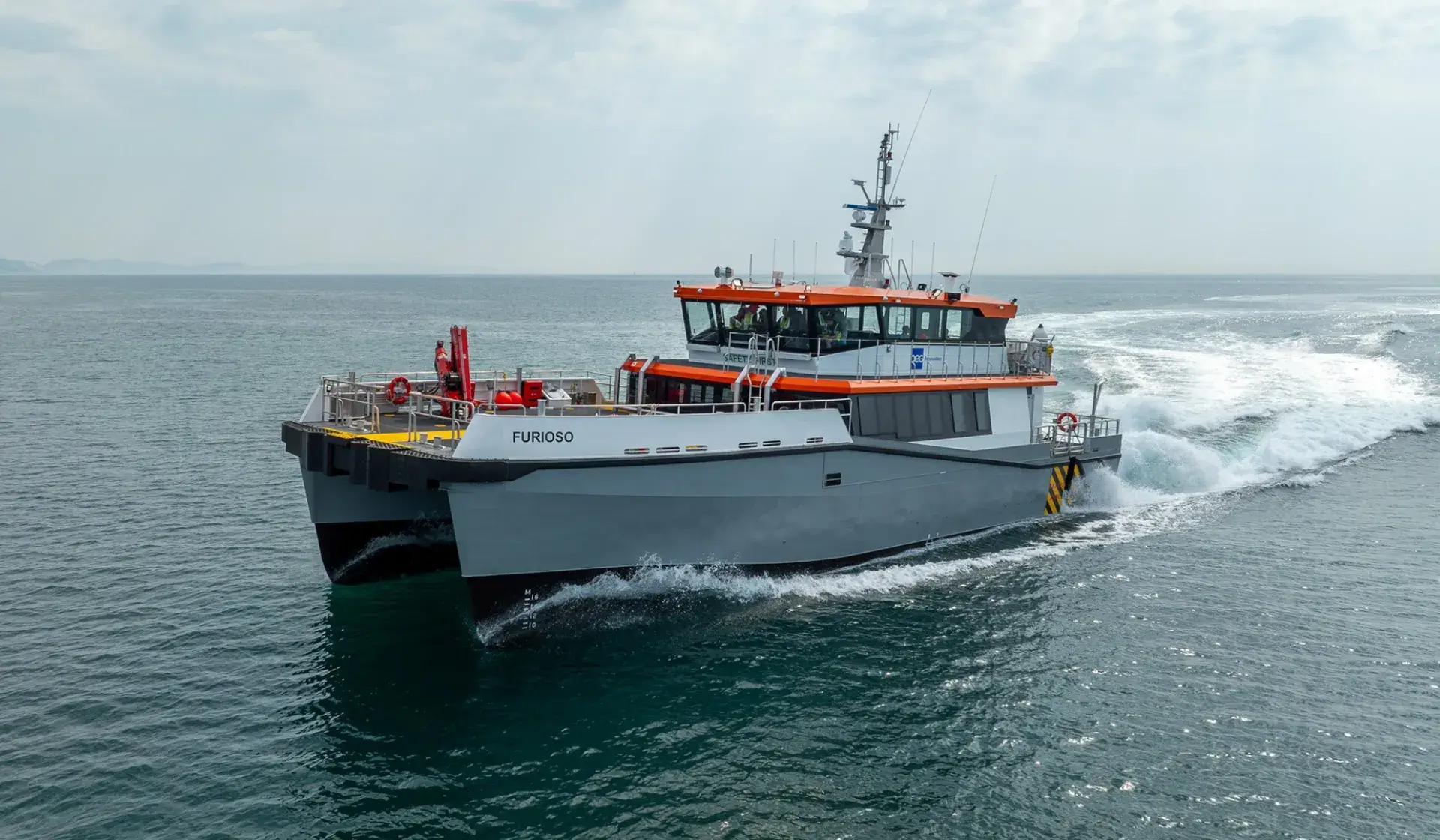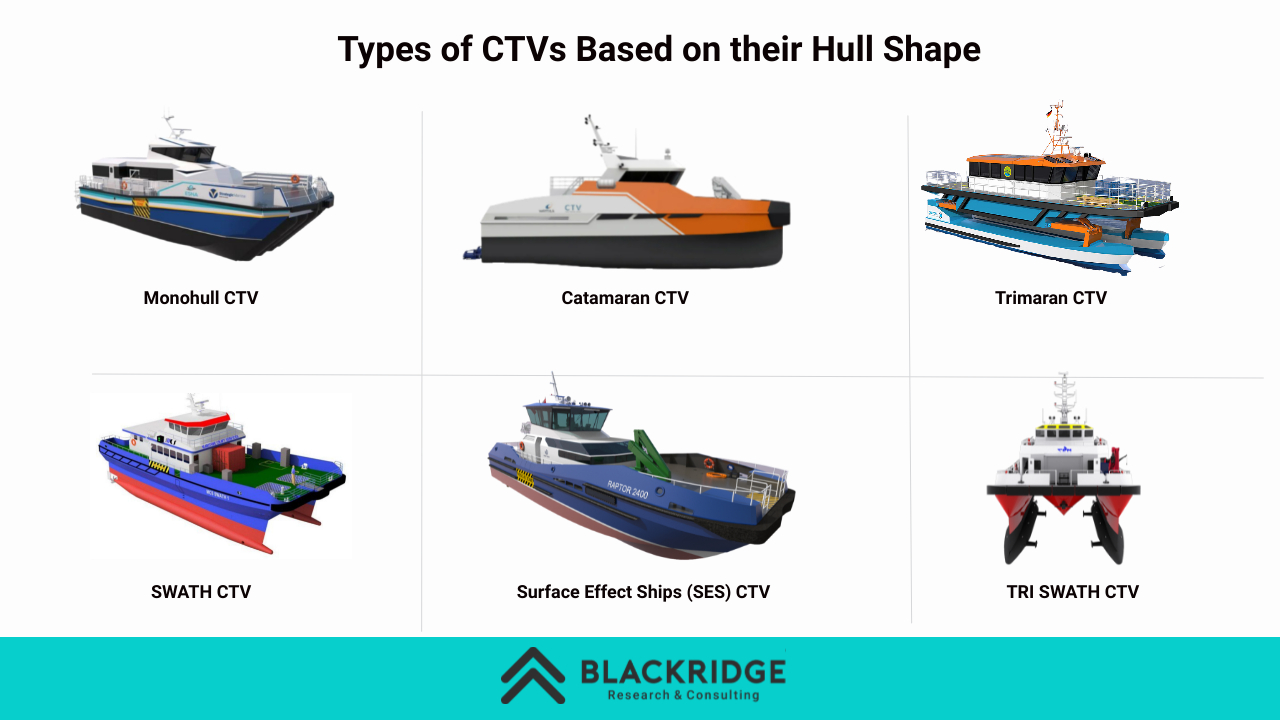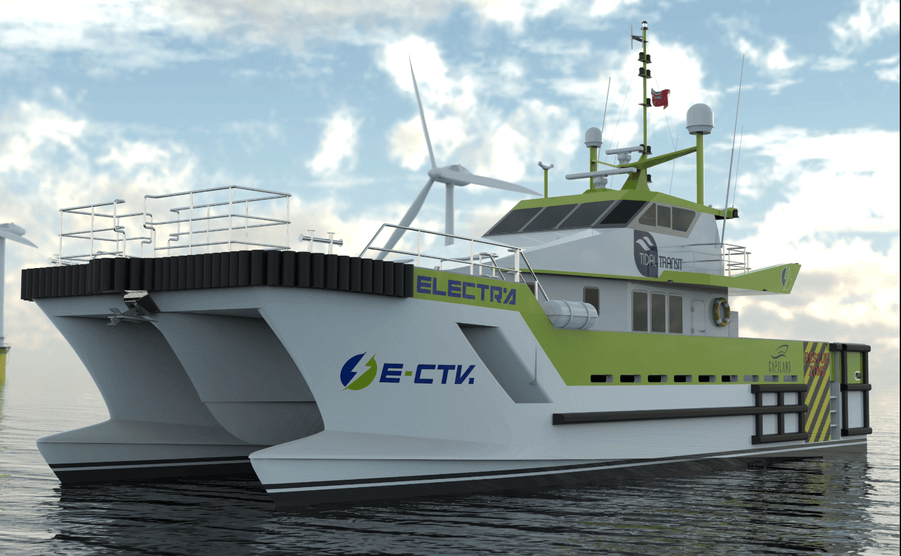Table of Contents
Offshore wind farms play a crucial role in energy transition and upgrading the global energy mix. The distance from land provides the advantage of strong and speedy winds but presents unique challenges. One of the primary challenges is building and maintaining these offshore structures.
The Crew Transfer Vessel (CTV) helps to tackle this by safely transporting crew members and cargo to the offshore wind farms. This maritime vessel plays an important role in the construction and operations & maintenance (O&M) of an offshore wind farm site.
According to Blackridge’s Global offshore support vessels market report, the global market for Crew Transfer Vessels (CTVs) in wind farms was valued at approximately USD 90 million in 2023, with a projected compound annual growth rate (CAGR) of 3.35% from 2024 to 2032.
In this blog, we'll explore the importance of CTVs in supporting the offshore wind sector and major CTV vessel companies in the world.
What Is a Crew Transfer Vessel (CTV)?
A Crew Transfer Vessel (CTV) is a ship designed to transport crew members and cargo to offshore infrastructures. The CTV vessel ensures the safe and fast transport of technicians, experts, and other personnel to offshore wind farms, oil rigs, or other offshore structures.

These vessels are also pivotal for the smooth operation of offshore sites located in deep ocean waters. CTVs are typically aluminum catamarans that can accommodate up to 12 passengers in transit. The CTVs are also built for rough sea conditions, enabling maintenance and other offshore activities in adverse weather.
CTVs typically range from 18 to 40 meters in length and are designed to travel at speeds of 15 to 25 knots, minimizing transfer downtime. The charter rate for a CTV per day is around GBP 2,000 (excluding fuel), depending on specification, availability, and contract period. Crew transfer means the process of moving people and equipment to and from a vessel.
Types of CTVs Based on their Hull Shape
Crew transfer vessels come in various designs, each manufactured to meet different operational requirements. Here, we explore six types of CTVs classified based on their hull shape:

Monohull Vessels
Monohull vessels are adapted from multi-purpose boats used for other marine activities. These were the first series of CTVs used in the construction of offshore wind farms. Monohull CTVs were popular in the early stages of offshore wind farm development due to their lower cost. Monohulls can only safely operate in sea states with wave heights between 1.2 and 1.5 meters.
Catamaran
Catamarans are CTVs made of aluminum that can achieve high speed and safely operate in medium sea conditions. The majority of CTVs used today are catamarans with twin-hull designs, and they offer better docking against wind turbine platforms. Catamaran CTVs can operate in wave heights of 1.5 to 2 meters and provide safe crew transfers.
Trimaran
Trimaran CTVs have recently entered the market as a more fuel-efficient alternative to traditional catamarans. These vessels combine the stability and speed of catamarans with a third hull to improve fuel efficiency and handling in rough seas. Trimarans are equipped with a gripper system that allows them to transfer crew safely in sea conditions with wave heights up to 2.5 meters.
Explore the Latest Trends in the Global CTV Market Collect Your Free Sample Here!
Small Waterplane Area Twin Hull (SWATH)
Small Waterplane Area Twin Hull (SWATH) vessel is another growing trend in the CTV market. This ctv ship have a unique hull design that minimizes the cross-sectional area at the water's surface and provides more stability.
SWATH vessels can operate in sea conditions with wave heights of 2.0 to 2.5 meters. SWATH CTVs are slower and more expensive than traditional catamarans but they are a strong option for projects requiring safe access in rough seas.
Surface Effect Ships (SES)
Surface Effect Ships (SES) have a hull shape similar to catamarans but feature an air cushion that lifts most of the vessel’s weight. The smaller weight of the vessel gives more speed and reduces fuel consumption. ES CTVs can operate at wave heights between 2.0 and 2.5 meters, and they are higher in cost.
TRI SWATH
The TRI SWATH Wind Farm Support Vessel is a new design that combines the fuel efficiency of a trimaran with the stability of a SWATH vessel. The advantage of such a design is that it is more stable and requires less fuel for propulsion than conventional designs.
How Do Crew Transfer Vessels Support Offshore Wind Farm Construction?
Crew Transfer Vessels (CTVs) provide support for the construction, operation, and maintenance of offshore wind farms. These vessels are mainly used for safely transporting wind farm technicians, engineers, and other personnel to offshore wind farm sites. CTVs are also a reliable means of transportation in adverse sea conditions and remote areas.
During the construction phase of an offshore wind farm, CTVs are used to shuttle workers and essential materials to and from the site. This includes electrical modules, oil products, maintenance tools, and daily supplies. CTVs also act as platforms for temporary storage and logistics coordination, enhancing offshore wind farms' seamless operation.
In the operation phase of a wind farm, CTVs are essential to carry out the operation and maintenance (O&M) of the offshore wind turbines. CTVs provide safe and efficient access for technicians who perform regular inspections and maintenance to ensure optimal performance of offshore wind farms.
As the offshore wind industry grows, more adaptable CTVs are required to meet the industry's demands. Modern CTV vessels are equipped with advanced features like anti-collision systems, sea rescue capabilities, and stability enhancements to ensure safe operations. They minimize downtime by reducing travel time to the site and enhancing access to turbines even in adverse weather.

In 2024, Tidal Transit began the design and engineering phase of a project to deliver the world’s first retrofit electric crew transfer vessel (E-CTV). The project is supported with GBP 6.3 million (about EUR 7.3 million) funding from the Zero Emissions Vessel and Infrastructure (ZEVI) competition. This was an initiative of the UK's Department of Transport to develop, deploy, and operate clean maritime solutions.
What Is the Difference Between CTV and SOV?
| Feature | Crew Transfer Vessel (CTV) | Service Operation Vessel (SOV) |
| Primary Function | Short-term crew and equipment transport | Long-term crew accommodation and support |
| Size | Typically, 18-40 meters | Often exceed 70 meters |
| Capacity | Up to 24 passengers, limited equipment | Ample living quarters, workshops, and storage |
| Duration of Stay | Day trips | Weeks-long missions |
| Use Cases | Quick, frequent transfers for maintenance or installation | Extended operations, maintenance, or service |
| Cost | More cost-effective for short-term transfers | More expensive due to size and extended operations |
Top CTV vessel companies
In the specialized CTV market, several companies lead the construction and development of CTVs. Here, we explore some of the top CTV companies that provide services to offshore wind farms worldwide:
Windcat Workboats
Windcat Workboats is one of the leading CTV companies in Europe. The company has a track record of over 950,000 safe and secure transfer services in the offshore sector. In 2023, Windcat Workboats had 31 operational vehicles in their fleet. The company has provided services to top offshore wind farms in the UK, namely Gunfleet Sands, Lynn & Inner Dowsing, London Array, and Robin Rigg.
The Windcat Workboats fleet features several vessel types, including:
MK1: Built in 2006 and 2007 with a length of 15m, these vessels are equipped with Volvo D12 engines.
MK2: Built in 2016-17 with a length of 15m, these CTV series are also equipped with Volvo D12 engines.
MK3: Built-in 2008, with a length of 18m, these CTVs come with larger lounge areas for passengers. The vessels are equipped with Volvo D16 engines or MTU2000 V8 engines.
MK3 Raised Wheelhouse series: New development on the MK3 platform, creating a large forward deck space to carry more goods.
MK4: This is a new series in Windcat Workboats' fleet with a capacity to carry 45 passengers. Built for operating in remote and harsh offshore wind farms.
Atlantic Wind Transfers
Atlantic Wind Transfers is the first U.S. offshore wind farm crew transfer vessel company. The company has performed over 25,000 transfers to date, along with nearly 6,600 TP landings. All CTVs are built to U.S. Coast Guard Classification and are able to operate around 100 nautical miles offshore.
The Atlantic Wind Transfers fleet features several vessel types, including:
CTV 1 Atlantic Pioneer: The CTV 1 series was built by Blount Boats in 2016 and has a crew capacity of around 2 or 3. The vessel has a dimension of 62 ft. x 24 ft. x 4 ft and was contracted by Orsted for Operations & Maintenance (O&M) of Block Island Wind Farm.
CTV 2 Atlantic Endeavor: CTV 2 was built by Blount Boats in 2020 with a crew capacity of 3-4 personnel. This wind farm service vessel adheres to Right Whale protection guidelines, which influence its dimensions and operational capabilities. This series was contracted by Dominion Energy for O&M of Coastal Virginia Offshore Wind.
MHO-Co
MHO-Co is a CTV one of the top vessel operators founded in 2015 and headquartered in Denmark. In 2019, MHO-Co launched the first twin vessels, MHO Gurli and MHO Esbjerg. These aluminum catamarans are considered the largest CTVs in the world at a length of 39m. In 2021, MHO-Co launched MHO Asgard and MHO Apollo. These two 35m offshore support vessels have fully integrated hybrid electric solutions for future eco-friendly power-generating methods.
The MHO-Co fleet features several vessel types, including:
MHO Balder: MHO Balder is one of the latest CTV designs built in 2024. The CTV vessel is 34m in length, and 4 IPS electric motors power it.
MHO Boreas: MHO Boreas is designed for the northern sea and can carry a crew of 3-8 members, depending on the task. This versatile ship can work under any weather condition and location.
MHO Asgard: These are one of the CTVs with futuristic design and technologies. The 35m catamaran was launched in September 2021 and can carry up to 24 passengers.
Find the Leaders in the Global OSV (Offshore Support Vessel) Market Collect Your Free OSV Report Here!
Conclusion
Crew Transfer Vessels (CTVs) are essential assets in the construction, operation, and maintenance of offshore wind farms. CTV boats ensure the safe and efficient transfer of crew members, cargo, and critical supplies to offshore locations. The CTV market is also in positive growth to comply with the ever-transforming offshore wind industry. Modern CTVs are designed to handle rough sea conditions, reduce fuel consumption, and decrease crew transfer time. Eco-friendly and Hybrid CTVs are in the pipeline of major companies like OEG Renewables and continue to evolve alongside the offshore wind industry.
Stay Ahead in Offshore Wind Farm Construction with Advanced Crew Transfer Vessels!
Learn about the latest trends and forecasts in the global Crew Transfer Vessel (CTV) market to make informed decisions for your offshore projects.
Discover key insights on CTV innovations and market growth in the latest Offshore Support Vessels Market Report by Blackridge Research!
Stay competitive with data-driven strategies.
Download the full report now to explore how CTVs are shaping the future of offshore wind farms.







Leave a Comment
We love hearing from our readers and value your feedback. If you have any questions or comments about our content, feel free to leave a comment below.
We read every comment and do our best to respond to them all.